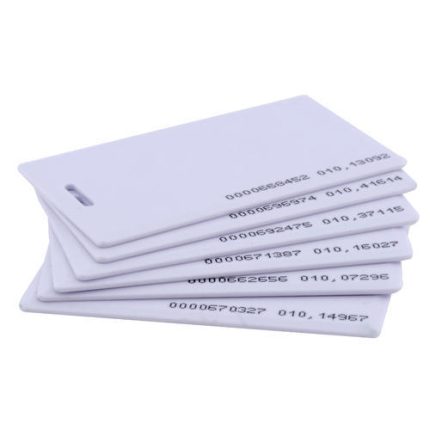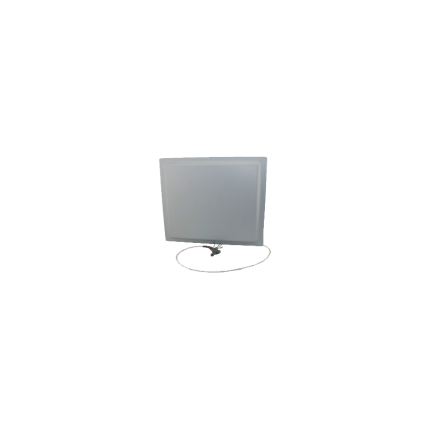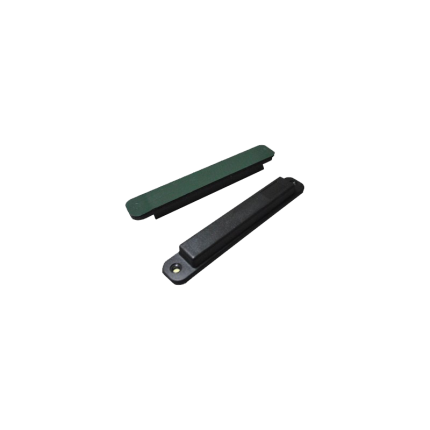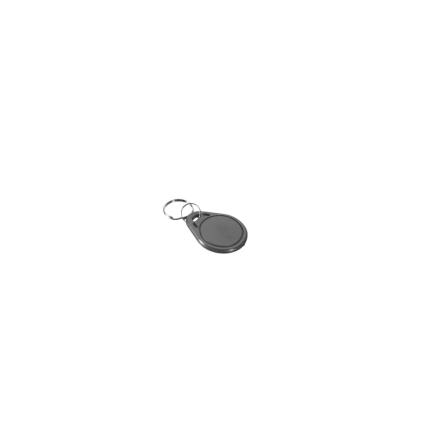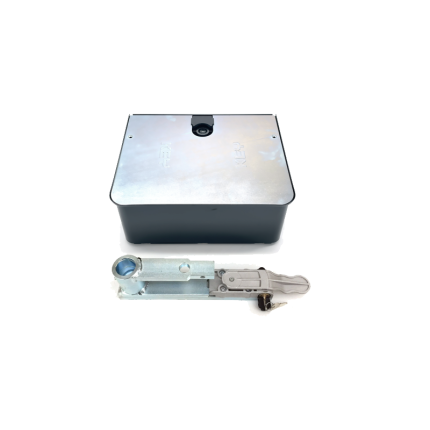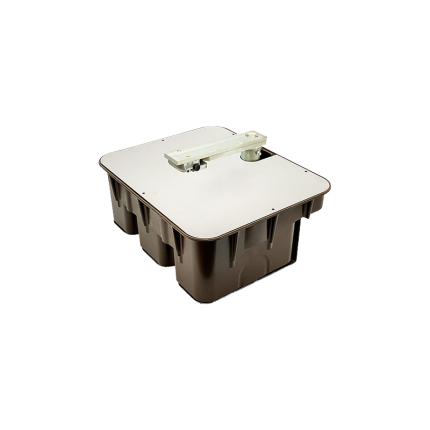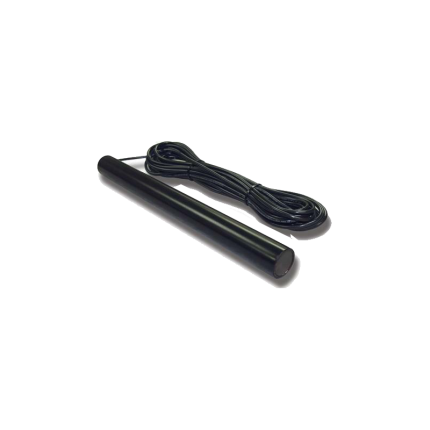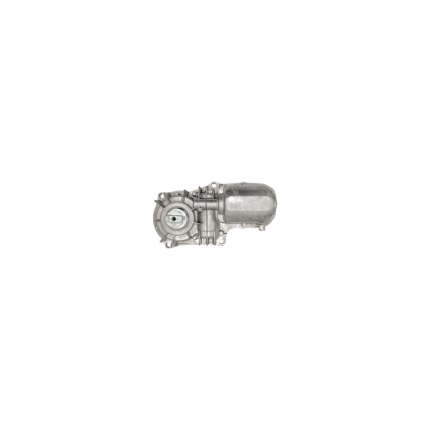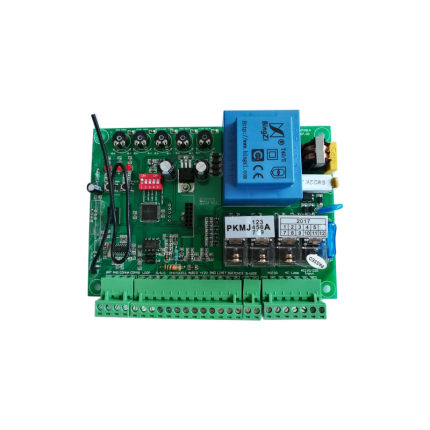Shop
UHF Card
Ship or pick up from our office.
UHF Card
UHF (Ultra High Frequency) Card Access Control is a system that uses Ultra High Frequency Radio-Frequency Identification (UHF RFID) technology for managing and controlling access to various areas. Unlike traditional access control systems that require a close proximity tap or swipe, UHF systems leverage the longer read range of UHF RFID to provide hands-free, faster, and more efficient access. How it Works ⚙️ The core components of a UHF Card Access Control system are:- UHF Cards/Tags: These are typically cards, key fobs, or even vehicle tags embedded with a UHF RFID inlay. They contain a unique identification number or other encoded data.
- UHF Readers: These devices emit radio waves in the UHF frequency range (typically 860-960 MHz). When a UHF card/tag enters the reader's range, the tag is powered by the radio waves and transmits its unique data back to the reader.
- Antennas: Integrated within or connected to the readers, these are responsible for transmitting and receiving the radio signals.
- Access Control Software/System: This software receives the data from the reader, verifies the tag's credentials against a database, and then grants or denies access based on predefined rules. If access is granted, it sends a signal to unlock a door, open a gate, etc.
- Tag enters field: A person with a UHF card or a vehicle with a UHF tag approaches the reader.
- Reader transmits signal: The UHF reader continuously emits radio waves.
- Tag responds: The passive UHF tag, powered by the reader's signal, transmits its unique ID back.
- Data received and processed: The reader captures the tag's data and sends it to the access control system.
- Access granted/denied: The system verifies the credentials and, if authorized, activates the access point (e.g., opens a barrier). This entire process happens wirelessly and often within milliseconds.
- Long Read Range: Unlike Low Frequency (LF) and High Frequency (HF) RFID systems, UHF can read tags from several meters away (up to 10-15 meters or more depending on the setup). This allows for hands-free access, such as for vehicles entering a parking lot or individuals walking through a gate without stopping.
- High-Speed Data Transmission and Multiple Tag Reading: UHF readers can read many tags simultaneously and quickly (hundreds of tags per second). This is crucial for high-traffic areas, reducing bottlenecks and improving efficiency.
- Convenience and Efficiency: Users don't need to physically present or swipe a card, leading to a smoother and faster access experience. This is especially beneficial in applications like vehicle access, parking management, and large event entry.
- Enhanced Security: UHF tags are difficult to counterfeit, and the systems often incorporate encryption and password protection to prevent unauthorized access and data manipulation. Real-time tracking capabilities can also enhance security oversight.
- Scalability and Centralized Management: Cloud-based UHF access control platforms allow administrators to manage users, permissions, and access points remotely and in real-time, making it easy to scale for larger organizations or multiple locations.
- Durability and Cost-Effectiveness (Long Term): UHF components are generally robust and durable, leading to lower maintenance and replacement costs over time compared to traditional systems.
- Low Frequency (LF) RFID (125-134 kHz):
- Read Range: Very short (typically a few centimeters).
- Characteristics: Less susceptible to interference from metal and liquids.
- Common Uses: Animal identification, car immobilizers, older access control systems where close proximity is acceptable.
- High Frequency (HF) RFID (13.56 MHz):
- Read Range: Short (up to 1 meter).
- Characteristics: Good for secure data transfer and applications requiring closer interaction. Often used with Near Field Communication (NFC).
- Common Uses: Contactless payments (e.g., Apple Pay, Google Pay), smart cards for building access, public transport ticketing, library systems.
- Ultra High Frequency (UHF) RFID (860-960 MHz):
- Read Range: Long (several meters up to 15+ meters).
- Characteristics: Ideal for long-range, high-speed identification of multiple items. More susceptible to interference from metals and liquids than LF/HF, though specialized tags and antenna designs can mitigate this. The industry standard for passive UHF RFID is often referred to as RAIN RFID.
- Common Uses: Vehicle access control, inventory management, supply chain tracking, asset tracking, automated toll collection, large-scale personnel tracking.
UHF Gate Controller
Ship or pick up from our office.
UHF Gate Controller
A UHF Gate Controller is a system that uses Ultra-High Frequency (UHF) Radio Frequency Identification (RFID) technology to manage and control access through a gate or designated entry/exit point. It typically consists of a UHF RFID reader, antennas, and a control unit that processes the data and triggers the gate mechanism. It's designed for automated, hands-free identification and tracking of people or objects equipped with UHF RFID tags, offering a longer read range and faster processing compared to other RFID frequencies. How it Works The fundamental principle of a UHF Gate Controller relies on the interaction between a UHF RFID reader and UHF RFID tags. Here's a breakdown:- UHF RFID Reader and Antennas: The gate controller incorporates a UHF RFID reader connected to one or more antennas. These antennas emit radio waves in the UHF frequency band (typically 860-960 MHz).
- RFID Tags: People, vehicles, or items needing access are equipped with UHF RFID tags. These tags contain a microchip that stores data (like a unique ID) and an antenna. Passive UHF tags, which are common in these systems, do not have their own power source; they draw power from the radio waves emitted by the reader.
- Data Exchange: When a tagged item or person enters the read range of the gate's antennas, the RFID tag is energized by the reader's radio waves. The tag then modulates these waves to send its stored data back to the reader.
- Data Processing and Control: The UHF RFID reader receives the tag's data and sends it to a control unit (often an integrated part of the gate system or a separate access controller). This control unit verifies the tag's information against a database of authorized entries.
- Gate Activation: If the tag is authorized, the control unit sends a signal to open or enable the gate (e.g., a barrier arm, turnstile, or door lock). If the tag is unauthorized, access is denied, and an alarm might be triggered.
- Directional Detection and Anti-Collision: Advanced UHF gate controllers can detect the direction of movement (e.g., entering or exiting) and employ anti-collision algorithms to read multiple tags simultaneously, even in high-traffic scenarios. Some systems use additional sensors (like infrared) to improve accuracy and prevent "tailgating."
- Long Read Range: Typically able to read tags from several meters away, allowing for "hands-free" and "drive-through" access.
- High Reading Speed: Can quickly identify multiple tags in motion, reducing bottlenecks.
- Anti-Collision: Algorithms that allow the reader to differentiate and read multiple tags present in the field at the same time.
- Directional Sensing: Ability to determine if an item or person is entering or exiting the controlled area.
- Integration Capabilities: Often connect with other security or management systems via interfaces like Ethernet, RS232, RS485, or Wi-Fi.
- Robust Design: Many are built for industrial or outdoor environments, with resistance to dust and water.
- Vehicle Access Control: Managing entry and exit for parking lots, gated communities, corporate campuses, and toll roads. Vehicles can have tags on windshields, allowing for seamless, hands-free access.
- People Access Control: Controlling access to buildings, restricted areas, and for time and attendance tracking in offices, universities, hospitals, and event venues.
- Logistics and Warehouse Management: Monitoring the flow of goods, pallets, and containers in and out of warehouses, distribution centers, and production lines for inventory management, asset tracking, and theft prevention.
- Retail: Used at store exits for Electronic Article Surveillance (EAS) to prevent shoplifting, and for inventory tracking as items move in and out of the backroom.
- Libraries and Document Management: Tracking books, documents, and other assets as they enter or leave a facility.
- Manufacturing: Monitoring materials and finished products on production lines and at factory entrances/exits.
UHF Label
Ship or pick up from our office.
UHF Label
A UHF (Ultra-High Frequency) label access control system uses radio-frequency identification (RFID) technology operating in the ultra-high frequency range (typically 860-960 MHz) to manage and control access to specific areas, buildings, or resources. It's a touchless, automated system that offers long-range reading capabilities and the ability to identify multiple items simultaneously, making it highly efficient for various applications like vehicle access, personnel tracking in large facilities, and event management. 🛂 How it Works The core principle of a UHF label access control system relies on the communication between RFID tags (labels) and RFID readers. Here's a breakdown of the process:- RFID Tags (Labels): These are small electronic devices, often in the form of adhesive labels, cards, or embedded devices. They contain a microchip that stores unique identification data and an antenna. Most UHF tags used in access control are passive, meaning they don't have their own power source and rely on the energy emitted by the reader.
- RFID Reader: The reader emits radio waves, creating an electromagnetic field. When a UHF RFID tag enters this field, it absorbs energy from the waves, which powers its microchip.
- Data Transmission: Once activated, the tag modulates the waves to transmit its stored data (its unique ID) back to the reader.
- Data Processing and Verification: The reader captures and decodes this data, then sends it to a central access control system (often a computer with specialized software and a backend database). The system verifies the tag's unique ID against a list of authorized credentials and pre-defined access rules.
- Access Granting/Denial: If the tag is authorized, the system sends a signal to unlock a door, open a gate, or grant access. If not authorized, access is denied, and the system may trigger an alarm or log the attempted entry.
- Logging: The system typically records all entry and exit events, providing a detailed audit trail for security and management purposes.
- UHF RFID Tags/Labels: These are the physical identifiers worn by individuals or attached to vehicles/assets. They store the unique ID and are read by the system.
- UHF RFID Readers: These devices emit radio waves to power and read the data from the tags. They are strategically installed at entry/exit points (e.g., doorways, gates). Fixed readers are common for specific zones, while handheld readers offer flexibility for mobile applications like inventory or searching for tags.
- Antennas: Connected to the readers, antennas are responsible for transmitting and receiving the radio signals. The type and placement of antennas affect the read range and coverage area.
- Access Control Software/System: This is the "brain" of the system. It manages the database of authorized tags, processes the data received from readers, applies access rules, and controls the locking mechanisms. It often integrates with other security or building management systems.
- Backend Database: Stores all the information related to RFID tags, authorized users, access levels, and event logs.
- Locking Mechanisms: These are the physical devices controlled by the system, such as electronic door locks, gate barriers, or turnstiles.
- Long Read Range 📏: UHF systems can read tags from several meters away (typically 3-10 meters, and sometimes up to 25 meters or more), allowing for hands-free and rapid access, particularly useful for vehicles or large volumes of people.
- High-Speed Data Transmission and Multi-Tag Reading ⚡: They can read multiple tags simultaneously (often over 100 tags per second), significantly improving efficiency in high-traffic areas and during events.
- Enhanced Efficiency ⏱️: Automation of access eliminates manual checks, reduces queuing times, and frees up staff for other tasks.
- Improved Security 🔒: Each tag has a unique identifier, making it difficult to forge or duplicate. The system provides real-time monitoring and detailed audit trails, enhancing accountability and security. Integration with other systems like surveillance cameras can further bolster security.
- Touchless Operation 🖐️: The long read range enables touchless access, which is beneficial for hygiene, particularly in high-traffic areas or environments where physical contact should be minimized.
- Scalability 📈: UHF RFID systems can be easily scaled to accommodate a growing number of users and access points without compromising performance.
- Durability and Resistance 💪: UHF tags are often resistant to environmental factors like water, oil, and chemicals, and the data stored on their chips is protected. They can also be reused.
- Reduced Wear and Tear: As there's no physical contact with readers, the system components experience less wear and tear, leading to lower maintenance costs.
UHF Licence Plate
Ship or pick up from our office.
UHF Licence Plate
A UHF (Ultra High Frequency) Licence Plate access control system is a vehicle identification and access management solution that uses UHF RFID (Radio Frequency Identification) technology to automatically grant or deny entry to vehicles. Instead of relying on traditional license plate recognition (ANPR/LPR) which uses cameras to read visible plates, UHF systems use RFID tags, often in the form of stickers or cards, affixed to vehicles. 🚗 When a vehicle with a registered UHF RFID tag approaches an access point (like a gate or barrier), a UHF reader emits radio waves. The tag, powered by these waves, transmits its unique identification data back to the reader. This data is then sent to an access control system which verifies the vehicle's authorization. If authorized, the system triggers the gate to open, allowing for fast, hands-free, and seamless entry and exit. This technology is widely used in places requiring efficient and secure vehicle flow, such as:- Gated communities 🏡
- Parking facilities (corporate, commercial, residential) 🅿️
- Industrial sites and logistics hubs 🏭
- Toll roads 🛣️
- UHF RFID Tags: These are small, passive (battery-less) or semi-active devices that contain a microchip storing a unique identification number and an antenna. They are typically affixed to the vehicle's windshield or license plate. When exposed to radio waves from a reader, the tag's antenna collects energy, powering the microchip to transmit its data.
- UHF RFID Readers: These devices are installed at access points (e.g., gate entrances) and emit radio waves to detect and read the RFID tags on approaching vehicles. They have antennas to send and receive signals, and a processor to decode the data from the tags. UHF readers typically have a longer read range (up to 10-12 meters or more) compared to other RFID frequencies, allowing vehicles to pass without fully stopping.
- Access Control System (Software/Controller): This is the "brain" of the system. The reader sends the tag's ID number to this system. The access control software then compares this ID with its database of authorized vehicles. Based on pre-defined criteria (e.g., specific times of day, authorized user groups), it determines whether to grant or deny access.
- Barrier/Gate System: If access is granted by the control system, a signal is sent to the physical barrier (like a boom gate or sliding gate), which opens to allow the vehicle to pass.
- Speed and Efficiency 🚀: Vehicles don't need to stop or roll down windows, significantly reducing traffic congestion, especially during peak hours. This provides a "frictionless" entry experience.
- Long Read Range 📏: UHF RFID allows for detection from several meters away, enabling quick processing of vehicles even at higher speeds.
- Reliability in Diverse Conditions 🌧️☀️: Unlike optical ANPR systems that can be affected by dirt, rain, snow, or poor lighting, UHF RFID tags are generally more robust and less susceptible to environmental factors.
- Enhanced Security 🔒: RFID tags are difficult to duplicate or tamper with, offering a higher level of security than some other methods. The system also logs all entries and exits, providing a clear audit trail.
- Reduced Operational Costs 💰: Automation minimizes the need for manual gate attendants, leading to lower labor costs over time. There's also no need for physical cards or key fobs that can be lost or damaged, saving on replacement costs.
- Integration Capabilities 🔗: These systems can often integrate seamlessly with other security and management platforms, such as visitor management systems, surveillance cameras, and parking management software, for a comprehensive solution.
UHF Tag
Ship or pick up from our office.
UHF Tag
A UHF (Ultra-High Frequency) tag access control system is a security solution that uses radio frequency identification (RFID) technology operating in the ultra-high frequency range (typically 860-960 MHz) to control and monitor entry and exit of individuals or vehicles to restricted areas. 🛂 It's an automated system that identifies an individual or object with a unique RFID tag and, based on pre-defined permissions, grants or denies access. Unlike traditional barcode systems, UHF RFID doesn't require a direct line of sight between the tag and reader, allowing for longer read ranges and the ability to read multiple tags simultaneously. How It Works A UHF tag access control system generally consists of four main components:- UHF RFID Tags: These are small electronic devices containing a microchip and an antenna. The microchip stores data, such as a unique identifier or user information. Passive UHF tags, the most common type, are powered by the electromagnetic field emitted by the reader. Active tags have their own battery, enabling longer read ranges and continuous data transmission.
- UHF RFID Readers: These devices emit radio waves to create an electromagnetic field. When a UHF tag enters this field, it absorbs energy (for passive tags) and uses it to power its microchip. The tag then modulates the waves to transmit its stored data back to the reader. Readers can be fixed at entry points (like doors or gates) or handheld.
- Antennas: Integrated with the reader, antennas are responsible for transmitting and receiving the radio signals. Their design and placement are crucial for optimizing read performance and range.
- Access Control Software/Server: This is the "brain" of the system. The reader sends the decoded tag data to the software, which compares it against a database of authorized users and their assigned access levels. If the credentials match, the software sends a signal to unlock the door, open a gate, or trigger another access action. This software also logs all access events, providing an audit trail.
- Long Read Range: UHF systems can read tags from several meters away, making them ideal for applications like vehicle access control where you don't need to stop and present a card.
- High Read Speed and Multi-Tag Reading: They can quickly read multiple tags at once, which is beneficial in high-traffic areas or for tracking numerous assets simultaneously.
- Automation and Efficiency: Automated identification eliminates the need for manual checks, speeding up entry and exit processes.
- Enhanced Security: By identifying individuals and logging access events, these systems improve security and accountability. Features like encryption and unique IDs help prevent unauthorized access and cloning.
- Durability: UHF tags are often designed to be robust and can withstand various environmental conditions, making them suitable for outdoor or industrial use.
- Scalability: Systems can be easily expanded to cover more access points or accommodate a larger number of users.
- Vehicle Access Control: Automatically granting access to parking lots, gated communities, or corporate campuses without requiring drivers to stop and swipe a card.
- Building and Room Access: Controlling entry to offices, secure areas, or sensitive facilities for employees and authorized personnel.
- Event Management: Using RFID-enabled wristbands or badges for quick and efficient entry to concerts, theme parks, or VIP areas.
- Asset Tracking: While primarily for access, the same technology can track the movement of valuable assets within a controlled environment.
- Personnel Tracking: Monitoring the presence and movement of staff within a facility for safety or operational purposes.
- Interference: Performance can be affected by certain materials like metal and liquids in the environment, which can interfere with radio waves.
- Cost: Initial installation costs can be higher compared to simpler access control methods due to the specialized hardware and software.
- Regulatory Compliance: UHF frequencies are not globally harmonized, meaning system components must comply with regional radio regulations.
- Security Risks: While secure, like any digital system, there's a potential for sophisticated cloning or hacking attempts if not properly secured with encryption and robust protocols.
Underground dual swing gate opener -Key Automation UND3024
Ship or pick up from our office.
Product Sheet PDFUnderground dual swing gate opener -Key Automation UND3024
*Suitable gate weight: Maximum 600 Kg (Per leaf) Included: *2 x Electromechanical motor *2 x Foundation box *1 x Main control board *1 x KUBE *1 x Waterproof box *2 x Remote control *2 x Manual release key *1 x Set safety sensorThe Key Automation UND3024 is an underground dual swing gate opener system, designed for automating the opening and closing of swing gates, particularly those with two leaves that meet in the middle.
It is known for its discreet, almost invisible, installation, with the motor and mechanism hidden underground. This makes it a popular choice when aesthetics are a priority.
Here's a more detailed breakdown:
-
Dual Swing Configuration:The UND3024 is specifically designed for gates with two leaves that swing open from a central point.
-
Underground Installation:The motor and operating mechanism are installed below ground, within foundation boxes, minimizing the visual impact of the system.
-
Electromechanical Operation:The system utilizes an electromechanical motor to drive the gate opening and closing mechanism.
-
Control System:A control board, housed in a separate waterproof box, manages the system's operation, receiving signals from remote controls or other access control devices.
-
Safety Features:The system typically includes safety features such as obstruction detection and an emergency release mechanism for manual operation.
-
Aesthetics:The underground design offers a discreet and aesthetically pleasing solution, particularly suitable for properties where appearance is a key consideration.
-
Applications:The UND3024 is suitable for both residential and light commercial use, automating driveway gates.
-
Components:The system usually includes two underground operators, foundation boxes, a control board, remote controls, and safety sensors.
Underground Dual Swing Gate Opener -VDS RG110
Ship or pick up from our office.
Product Sheet PDFUnderground Dual Swing Gate Opener -VDS RG110
*Suitable gate weight: Maximum 500 Kg (Per leaf) Included: *2 x Electromechanical motor *2 x Foundation box *1 x Main control board *1 x Waterproof box *2 x Remote control *2 x Manual release key *1 x Safety sensor The Swing gate opener -VDS Underground RG110 is one of the best underground swing gate operators that can be installed for the swing driveway gates. The Swing gate opener -VDS Underground RG110 is Italian-made and can be installed for heavy swing gates. *Electromechanical Motor *Maximum gate weight: 500 Kg *120 VUnderground single swing gate opener -Key Automation UND3024
Ship or pick up from our office.
Product Sheet PDFUnderground single swing gate opener -Key Automation UND3024
*Suitable gate weight: Maximum 600 Kg Included: *1 x Electromechanical motor *1 x Foundation box *1 x Main control board *1 x KUBE *1 x Waterproof box *2 x Remote control *1 x Manual release key *1 x Set safety sensorThe Key Automation UND3024 is an underground single swing gate opener.
It's designed for discreet, concealed automation of swing gates, meaning the motor and operating mechanism are installed underground, keeping the gate's appearance visually clean.
This system is suitable for both residential and commercial applications, offering a modern and robust solution for gate access.
Here's a more detailed explanation:
-
Concealed Installation:The motor and mechanical components are installed beneath the ground, within foundation boxes, making the system virtually invisible and preserving the gate's aesthetic.
-
Gate Compatibility:The UND3024 is designed to work with various gate materials, including steel, wood, and vinyl.
-
Operation:It utilizes an electric motor to power the gate's movement, with a control system that receives signals from remote controls, keypads, or other access control devices.
-
Key Features:
- Safety: Many models include features like anti-crushing devices and speed slowdown to ensure safe operation.
- Durability: Underground openers are often constructed with durable materials like die-cast aluminum and stainless steel to withstand outdoor conditions.
- Silent Operation: Underground openers can be engineered for quiet operation.
- Easy Installation: Some models offer simplified installation procedures.
- Optional Features: Battery backup, remote controls, and safety sensors are often available as optional additions.
- Safety: Many models include features like anti-crushing devices and speed slowdown to ensure safe operation.
-
Swing Gate Types:
- Single Swing: A single leaf gate that moves in one direction.
- Double Swing: A gate with two leaves that swing open from the center.
- Single Swing: A single leaf gate that moves in one direction.
-
Benefits of Underground Openers:
- Discreet Appearance: The concealed mechanism preserves the gate's aesthetics.
- Space Efficiency: They don't require the space needed for external motor arms.
- Durability: They are designed for long-term use and resistance to corrosion.
- Security: They can be an effective way to prevent unauthorized access to a property.
- Convenience: Automatic opening and closing of the gate with remote control or other access methods.
- Accessibility: Can be especially useful for people with mobility issues.
- Discreet Appearance: The concealed mechanism preserves the gate's aesthetics.
Underground swing gate opener -Key Automation UND3024
Ship or pick up from our office.
Underground swing gate opener -Key Automation UND3024
*Electromechanical Motor *Maximum gate weight: 600 Kg *DC 24 VUniversal sliding gate operator control board SLRG24
Ship or pick up from our office.
Universal sliding gate operator control board SLRG24
The Universal Sliding Gate Operator Control Board SLRG24 is the "brain" of an automatic sliding gate system. It's designed to be a versatile replacement or core component for various DC-powered sliding gate operators, meaning it can control a wide range of motors and integrate with different accessories. Here's a detailed look at its features and significance: Core Function of a Control Board: The control board is the central electronic unit that:- Receives Signals: Interprets commands from remote controls, keypads, safety sensors (photocells, shock sensors, loop detectors), intercom systems, and other access control devices.
- Processes Logic: Decides what action the gate should take based on the received signals and its programmed settings (e.g., open fully, partially open for pedestrian, close, stop, reverse due to obstruction).
- Activates Motor: Sends the appropriate electrical signals to the gate motor to start, stop, or reverse its movement.
- Manages Accessories: Controls the power and operation of connected safety and convenience accessories like flashing lights, electric locks, and alarm outputs.
- Universal Compatibility: This is its defining characteristic.
- DC Motor Compatibility: It's designed to work with both DC 12V and DC 24V motors. This flexibility is crucial as many sliding gate operators use one of these DC voltages. It's important to note that it is NOT compatible with AC (Alternating Current) motors (like 110V or 220V AC motors).
- Limit Switch Flexibility: It can work with both spring-type mechanical limit switches and magnetic limit switches. This is a significant advantage for a universal board, as it means it can be used with a wider range of existing gate operators.
- Input Power: The board itself typically requires an AC 24V input power. This means it likely has an internal transformer or is designed to be powered by an external AC 24V transformer.
- Full Programmability: Offers a wide range of adjustable parameters, allowing customization of gate operation to suit specific needs:
- Gate Speed: Adjustment of how fast the gate opens and closes.
- Opening/Closing Times: Setting precise durations for gate cycles.
- Automatic Closing Time: Programming a delay before the gate automatically closes after opening (e.g., 15, 30, 45 seconds, or up to 3 minutes).
- Safety Settings: Integration and management of safety sensors (photocells, obstacle detection sensitivity).
- Pedestrian Mode: Ability to set a partial opening for pedestrian access.
- Party Mode: Often allows for temporary cancellation of auto-close for periods when many visitors are expected.
- Remote Control Capability:
- Features an integrated radio receiver, typically operating at 433.92MHz with rolling code technology. Rolling code prevents unauthorized cloning of remote controls, enhancing security.
- Supports multiple remote controls (e.g., up to 20 or more), making it suitable for larger families or multi-user environments.
- Accessory Output Power: Provides DC 24V accessory output power (e.g., 200mA max) to power various external devices:
- Safety Sensors (Photocells): Connects to and powers safety beams.
- Warning Flash Lights: Powers a flashing beacon that activates when the gate is in motion.
- Keypads/Intercom Systems: Provides power and input connections for wired access control devices.
- Electric Locks: Can manage the operation of an electric lock for added security.
- Safety Mechanisms:
- Obstacle Detection: Uses current sensing or other methods to detect if the gate encounters an obstruction during movement. Upon detection, it will typically stop or reverse the gate for safety.
- Automatic Stop Function: Ensures the gate stops precisely at its programmed limits.
- Short Circuit Protection: Often includes protection for output circuits (e.g., lock output) to prevent damage from wiring faults.
- Solar System Input: The mention of "Input Solar system" suggests it's designed to be compatible with or directly connect to solar charging systems for off-grid gate installations, making it suitable for rural properties or areas without easy access to AC power.
- Installation and Durability:
- Designed for relatively easy installation.
- Built with robust components for long-lasting performance in various weather conditions, though it usually requires housing in a waterproof box (often included in a kit).
- Features an automatic power-off memory function, retaining settings after a power outage.
- Replacing a Faulty Board: If an existing 12V or 24V DC sliding gate operator has a non-functional control board, the SLRG24 could be a suitable and cost-effective replacement, reducing the need to replace the entire gate motor.
- New Custom Gate Systems: It provides a flexible "brain" for custom-built sliding gate systems where the motor and other components are chosen separately.
- Solar-Powered Gates: Its solar input capability is a definite advantage for properties in Surrey or surrounding areas that might prefer or require solar power for their gate.
USB Gate Opener Remote
Ship or pick up from our office.
USB Gate Opener Remote
A USB gate opener remote control is a device that allows you to open and close automatic gates or garage doors by plugging a USB dongle into your car's USB port and using it as a remote.
USB Gate Opener Remote emits a sensing signal upon receiving a command from the USB port, which then triggers the gate opener to open or close the driveway gate.
Here's a more detailed explanation:
How it works:
-
USB Gate Opener Remote Dongle:The device typically includes a small USB dongle that plugs into your car's USB port.
-
Sensing Signal:When the USB is plugged in and the car is in the "on" mode, the dongle emits a sensing signal.
-
Receiver:The signal is received by a unit connected to the driveway gate motor.
-
Gate Motor Activation:The receiver then activates the gate motor, causing the driveway gate to open or close.
Key features:
-
Dual Control Modes:Some models offer both automatic and manual modes, allowing you to operate the gate either by proximity sensing or by pressing a button on the USB dongle.
-
Compact and Portable:The USB dongle is small and lightweight, making it easy to use and store in your car.
-
Easy Installation:It's designed for simple plug-and-play functionality, requiring no complex setup.
-
Replacement Accessory:The USB gate opener remote serves as a convenient replacement for traditional gate remote controls.

